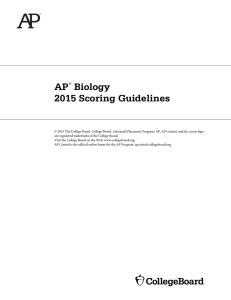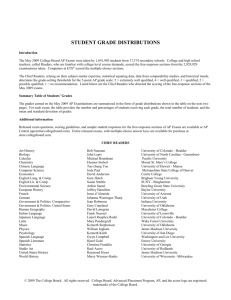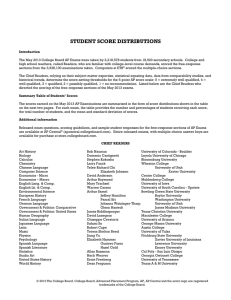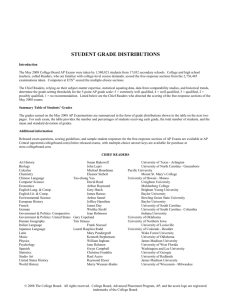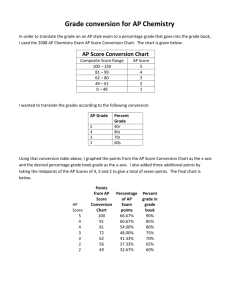AP Biology 2015 Free-Response Questions
advertisement
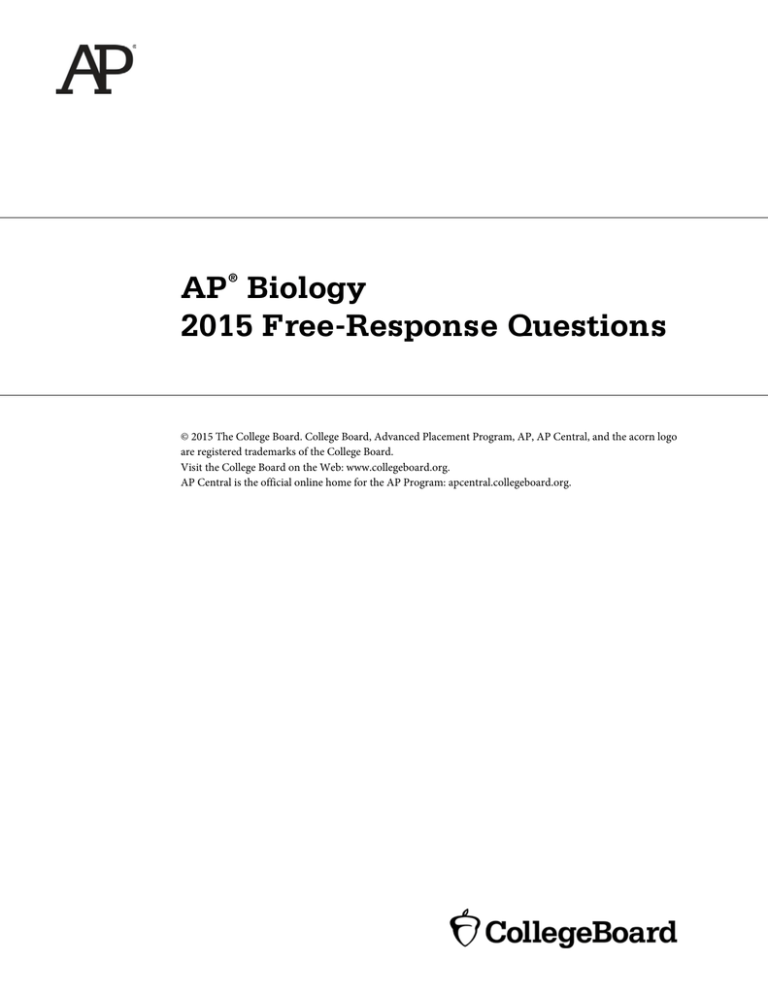
AP Biology 2015 Free-Response Questions ® © 2015 The College Board. College Board, Advanced Placement Program, AP, AP Central, and the acorn logo are registered trademarks of the College Board. Visit the College Board on the Web: www.collegeboard.org. AP Central is the official online home for the AP Program: apcentral.collegeboard.org. 2015 AP® BIOLOGY FREE-RESPONSE QUESTIONS BIOLOGY Section II 8 Questions Planning Time------10 minutes Writing Time------80 minutes Directions: Questions 1 and 2 are long free-response questions that require about 22 minutes each to answer and are worth 10 points each. Questions 3–8 are short free-response questions that require about 6 minutes each to answer. Questions 3–5 are worth 4 points each and questions 6–8 are worth 3 points each. Read each question carefully and completely. Write your response in the space provided for each question. Only material written in the space provided will be scored. Answers must be written out in paragraph form. Outlines, bulleted lists, or diagrams alone are not acceptable. 1. Many species have circadian rhythms that exhibit an approximately 24-hour cycle. Circadian rhythms are controlled by both genetics and environmental conditions, including light. Researchers investigated the effect of light on mouse behavior by using a running wheel with a motion sensor to record activity on actograms, as shown in Figure 1. Figure 1. Strategy for recording mouse activity data. When a mouse is active on the running wheel, the activity is recorded as a dark horizontal line on an actogram. When the mouse is inactive, no dark line is recorded. © 2015 The College Board. Visit the College Board on the Web: www.collegeboard.org. GO ON TO THE NEXT PAGE. -2- 2015 AP® BIOLOGY FREE-RESPONSE QUESTIONS For the investigation, adult male mice were individually housed in cages in a soundproof room at 25°C. Each mouse was provided with adequate food, water, bedding material, and a running wheel. The mice were exposed to daily periods of 12 hours of light (L) and 12 hours of dark (D) (L12:D12) for 14 days, and their activity was continuously monitored. The activity data are shown in Figure 2. Figure 2. Actogram of mouse activity under L12:D12 conditions. Each row represents a 24-hour period, and the dark horizontal lines represent activity on the running wheel. After 14 days in L12:D12, the mice were placed in continuous darkness (DD), and their activity on the running wheel was recorded as before. The activity data under DD conditions are shown in Figure 3. Figure 3. Actogram of mouse activity under DD conditions. Each row represents a 24-hour period, and the dark horizontal lines represent activity on the running wheel. © 2015 The College Board. Visit the College Board on the Web: www.collegeboard.org. GO ON TO THE NEXT PAGE. -3- 2015 AP® BIOLOGY FREE-RESPONSE QUESTIONS (a) The nervous system plays a role in coordinating the observed activity pattern of the mice in response to light-dark stimuli. Describe ONE role of each of the following anatomical structures in responding to lightdark stimuli. x A photoreceptor in the retina of the eye x The brain x A motor neuron (b) Based on an analysis of the data in Figure 2, describe the activity pattern of the mice during the light and dark periods of the L12:D12 cycle. (c) The researchers claim that the genetically controlled circadian rhythm in the mice does not follow a 24-hour cycle. Describe ONE difference between the daily pattern of activity under L12:D12 conditions (Figure 2) and under DD conditions (Figure 3), and use the data to support the researchers’ claim. (d) To investigate the claim that exposure to light overrides the genetically controlled circadian rhythm, the researchers plan to repeat the experiment with mutant mice lacking a gene that controls the circadian rhythm. Predict the observed activity pattern of the mutant mice under L12:D12 conditions and under DD conditions that would support the claim that light overrides the genetically controlled circadian rhythm. (e) In nature, mice are potential prey for some predatory birds that hunt during the day. Describe TWO features of a model that represents how the predator-prey relationship between the birds and the mice may have resulted in the evolution of the observed activity pattern of the mice. © 2015 The College Board. Visit the College Board on the Web: www.collegeboard.org. GO ON TO THE NEXT PAGE. -4- 2015 AP® BIOLOGY FREE-RESPONSE QUESTIONS Figure 1. Glycolysis and pyruvate oxidation Figure 2. Krebs cycle Figure 3. Electron transport chain 2. Cellular respiration includes the metabolic pathways of glycolysis, the Krebs cycle, and the electron transport chain, as represented in the figures. In cellular respiration, carbohydrates and other metabolites are oxidized, and the resulting energy-transfer reactions support the synthesis of ATP. (a) Using the information above, describe ONE contribution of each of the following in ATP synthesis. x Catabolism of glucose in glycolysis and pyruvate oxidation x Oxidation of intermediates in the Krebs cycle x Formation of a proton gradient by the electron transport chain (b) Use each of the following observations to justify the claim that glycolysis first occurred in a common ancestor of all living organisms. x Nearly all existing organisms perform glycolysis. x Glycolysis occurs under anaerobic conditions. x Glycolysis occurs only in the cytosol. © 2015 The College Board. Visit the College Board on the Web: www.collegeboard.org. GO ON TO THE NEXT PAGE. -5- 2015 AP® BIOLOGY FREE-RESPONSE QUESTIONS (c) A researcher estimates that, in a certain organism, the complete metabolism of glucose produces 30 molecules of ATP for each molecule of glucose. The energy released from the total oxidation of glucose under standard conditions is 686 kcal/mol. The energy released from the hydrolysis of ATP to ADP and inorganic phosphate under standard conditions is 7.3 kcal/mol. Calculate the amount of energy available from the hydrolysis of 30 moles of ATP. Calculate the efficiency of total ATP production from 1 mole of glucose in the organism. Describe what happens to the excess energy that is released from the metabolism of glucose. (d) The enzymes of the Krebs cycle function in the cytosol of bacteria, but among eukaryotes the enzymes function mostly in the mitochondria. Pose a scientific question that connects the subcellular location of the enzymes in the Krebs cycle to the evolution of eukaryotes. © 2015 The College Board. Visit the College Board on the Web: www.collegeboard.org. GO ON TO THE NEXT PAGE. -6- 2015 AP® BIOLOGY FREE-RESPONSE QUESTIONS 3. The amino acid sequence of cytochrome c was determined for five different species of vertebrates. The table below shows the number of differences in the sequences between each pair of species. THE NUMBER OF AMINO ACID DIFFERENCES IN CYTOCHROME c AMONG FIVE SPECIES E. ferus D. polylepis E. ferus D. polylepis G. gallus A. forsteri 0 21 11 13 1 0 18 17 20 0 3 10 0 12 G. gallus A. forsteri E. africanus E. africanus 0 (a) Using the data in the table, create a phylogenetic tree on the template provided to reflect the evolutionary relationships of the organisms. Provide reasoning for the placement on the tree of the species that is least related to the others. (b) Identify whether morphological data or amino acid sequence data are more likely to accurately represent the true evolutionary relationships among the species, and provide reasoning for your answer. © 2015 The College Board. Visit the College Board on the Web: www.collegeboard.org. GO ON TO THE NEXT PAGE. -7- 2015 AP® BIOLOGY FREE-RESPONSE QUESTIONS 4. Both mitosis and meiosis are forms of cell division that produce daughter cells containing genetic information from the parent cell. (a) Describe TWO events that are common to both mitosis and meiosis that ensure the resulting daughter cells inherit the appropriate number of chromosomes. (b) The genetic composition of daughter cells produced by mitosis differs from that of the daughter cells produced by meiosis. Describe TWO features of the cell division processes that lead to these differences. 5. Phototropism in plants is a response in which a plant shoot grows toward a light source. The results of five different experimental treatments from classic investigations of phototropism are shown above. (a) Give support for the claim that the cells located in the tip of the plant shoot detect the light by comparing the results from treatment group I with the results from treatment group II and treatment group III. (b) In treatment groups IV and V, the tips of the plants are removed and placed back onto the shoot on either a permeable or impermeable barrier. Using the results from treatment groups IV and V, describe TWO additional characteristics of the phototropism response. © 2015 The College Board. Visit the College Board on the Web: www.collegeboard.org. GO ON TO THE NEXT PAGE. -8- 2015 AP® BIOLOGY FREE-RESPONSE QUESTIONS 6. In an attempt to rescue a small isolated population of snakes from decline, a few male snakes from several larger populations of the same species were introduced into the population in 1992. The snakes reproduce sexually, and there are abundant resources in the environment. The figure below shows the results of a study of the snake population both before and after the introduction of the outside males. In the study, the numbers of captured snakes indicate the overall population size. (a) Describe ONE characteristic of the original population that may have led to the population’s decline in size between 1989 and 1993. (b) Propose ONE reason that the introduction of the outside males rescued the snake population from decline. (c) Describe how the data support the statement that there are abundant resources in the environment. © 2015 The College Board. Visit the College Board on the Web: www.collegeboard.org. GO ON TO THE NEXT PAGE. -9- 2015 AP® BIOLOGY FREE-RESPONSE QUESTIONS 7. Smell perception in mammals involves the interactions of airborne odorant molecules from the environment with receptor proteins on the olfactory neurons in the nasal cavity. The binding of odorant molecules to the receptor proteins triggers action potentials in the olfactory neurons and results in transmission of information to the brain. Mammalian genomes typically have approximately 1,000 functional odorant-receptor genes, each encoding a unique odorant receptor. (a) Describe how the signal is transmitted across the synapse from an activated olfactory sensory neuron to the interneuron that transmits the information to the brain. (b) Explain how the expression of a limited number of odorant receptor genes can lead to the perception of thousands of odors. Use the evidence about the number of odorant receptor genes to support your answer. 8. An individual has lost the ability to activate B cells and mount a humoral immune response. (a) Propose ONE direct consequence of the loss of B-cell activity on the individual’s humoral immune response to the initial exposure to a bacterial pathogen. (b) Propose ONE direct consequence of the loss of B-cell activity on the speed of the individual’s humoral immune response to a second exposure to the bacterial pathogen. (c) Describe ONE characteristic of the individual’s immune response to the bacterial pathogen that is not affected by the loss of B cells. STOP END OF EXAM © 2015 The College Board. Visit the College Board on the Web: www.collegeboard.org. -10-



